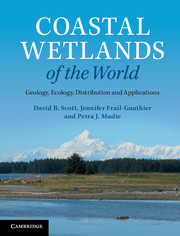Book contents
- Frontmatter
- Contents
- Preface
- List of acronyms and abbreviations
- 1 Introduction: what is covered in this coastal wetlands book?
- 2 Physical aspects: geological, oceanic and climatic conditions
- 3 Zonations and plants: development, stressors and adaptations
- 4 Animals in coastal wetlands: zonation, adaptations and energy flow
- 5 Human intervention causing coastal problems
- 6 Coastal wetlands worldwide: climatic zonation, ecosystems and biogeography
- 7 Examples of North American salt marshes and coastal wetlands
- 8 Examples of South American coastal wetlands
- 9 Africa: selected marsh and mangrove areas
- 10 Europe and Asia: a view of what remains
- 11 Australasia: wetlands of Australia and New Zealand
- 12 Applications in geological monitoring: paleoseismology and paleoclimatology
- 13 Applications in conservation of plant biodiversity and agriculture
- 14 Using mesocosms as a way to study coastal wetlands
- 15 Conclusions and future directions
- References
- Index
- Plate section
13 - Applications in conservation of plant biodiversity and agriculture
Published online by Cambridge University Press: 05 July 2014
- Frontmatter
- Contents
- Preface
- List of acronyms and abbreviations
- 1 Introduction: what is covered in this coastal wetlands book?
- 2 Physical aspects: geological, oceanic and climatic conditions
- 3 Zonations and plants: development, stressors and adaptations
- 4 Animals in coastal wetlands: zonation, adaptations and energy flow
- 5 Human intervention causing coastal problems
- 6 Coastal wetlands worldwide: climatic zonation, ecosystems and biogeography
- 7 Examples of North American salt marshes and coastal wetlands
- 8 Examples of South American coastal wetlands
- 9 Africa: selected marsh and mangrove areas
- 10 Europe and Asia: a view of what remains
- 11 Australasia: wetlands of Australia and New Zealand
- 12 Applications in geological monitoring: paleoseismology and paleoclimatology
- 13 Applications in conservation of plant biodiversity and agriculture
- 14 Using mesocosms as a way to study coastal wetlands
- 15 Conclusions and future directions
- References
- Index
- Plate section
Summary
Key points
Land plants evolved from marine algal ancestors, but only halophytes retained their ancestral salt tolerance; humans have used salt marsh biological resources to their advantage since at least Neanderthal times; coastal wetlands support a wide range of plants useful for food, fibre, oil and medicine; because modern agriculture began in highland areas, early crops were not selected for salt tolerance; crop loss from soil salinization has led to collapse of societies and/or warfare from Neolithic to modern times; agricultural salinization problems have increased as human population growth drives increased irrigation and depletion of groundwater. Coastal wetlands are storehouses of genetic salt specialization, which offer solutions for a new Green Revolution; novel foods and biofuels from wild halophytes allow desert agriculture, aiding the need to conserve freshwater, which is considered the greatest challenge to human survival.
Salt of the Earth
In Chapter 6 we discussed the role of long-term changes in the distribution of Earth’s continents and seas, which has shaped the diversity of coastal wetland floras over the past >66 Ma. In fact, environmental salt is a fundamental legacy of Earth’s evolution for more than 550 million years. As far back as Pangean time when there was only one supercontinent, there have been major sea level changes like those described in Chapter 2, and these have required ongoing adaption to alternating terrestrial and tidal regimes for coastal plants. Both aquatic algae and land plants (excluding mosses) responded to these shoreline changes during their evolution by developing salt-tolerance mechanisms across a wide range of taxonomic groups (Plants in Action, 1999). This convergent evolution in various mangrove trees, intertidal salt marsh and salt desert halophytes is manifest as similar mechanisms for salt exclusion by roots, salt excretion by leaves and as compartmentation of salt within fleshy leaf or stem tissue across widely separated taxonomic groups (Chapter 3). Other less well-developed mechanisms for salt exclusion and cellular compartmentation are also found in some non-halophytic wild plants and their cultivated varieties. This genetic variation in salt tolerance can be exploited for genetic improvement of commercially significant species or cultivars, especially when the mechanisms and inheritance of the salt tolerance is well understood.
- Type
- Chapter
- Information
- Coastal Wetlands of the WorldGeology, Ecology, Distribution and Applications, pp. 269 - 278Publisher: Cambridge University PressPrint publication year: 2014



